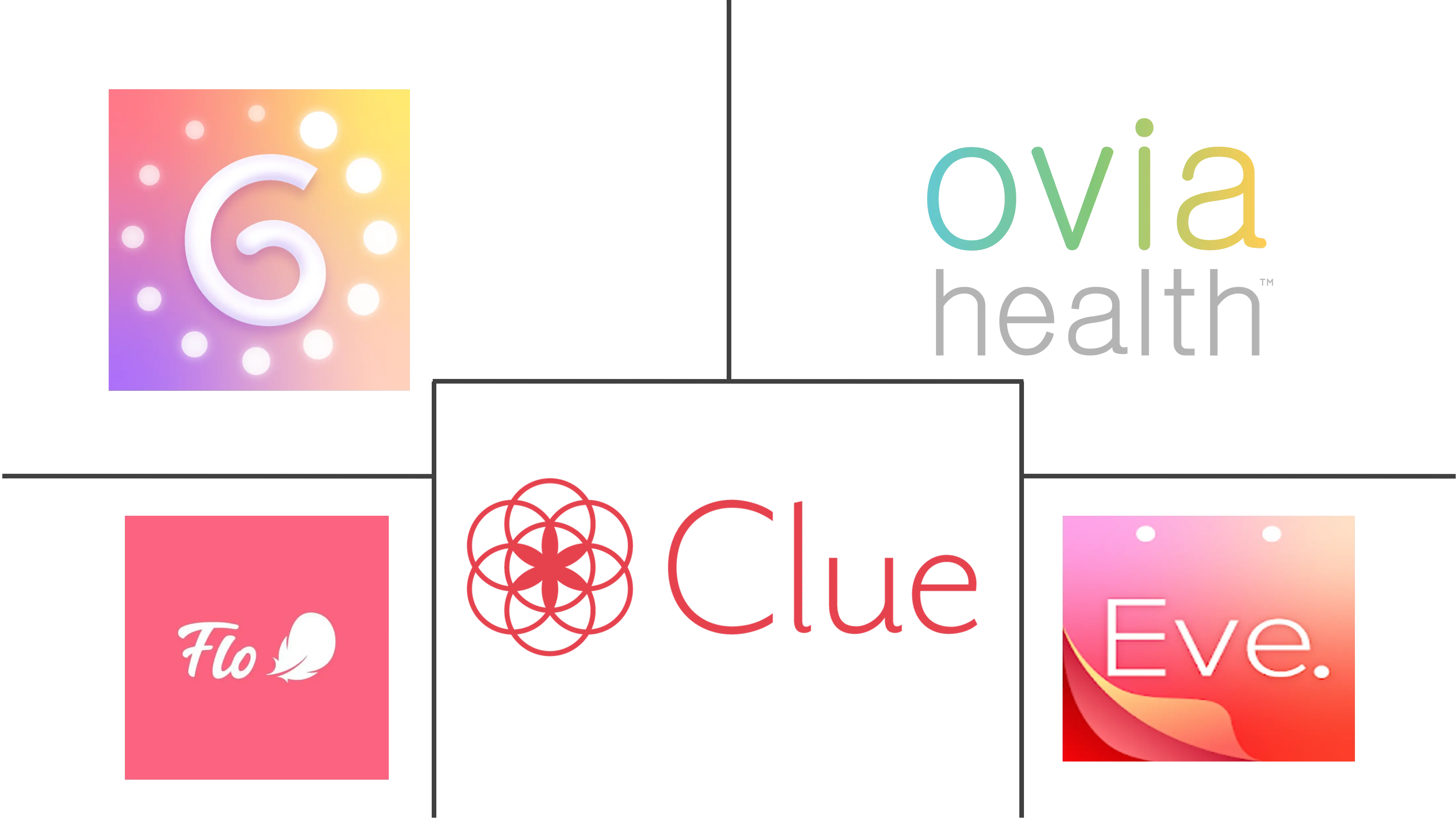Menstrual Health Apps Market Size and Share
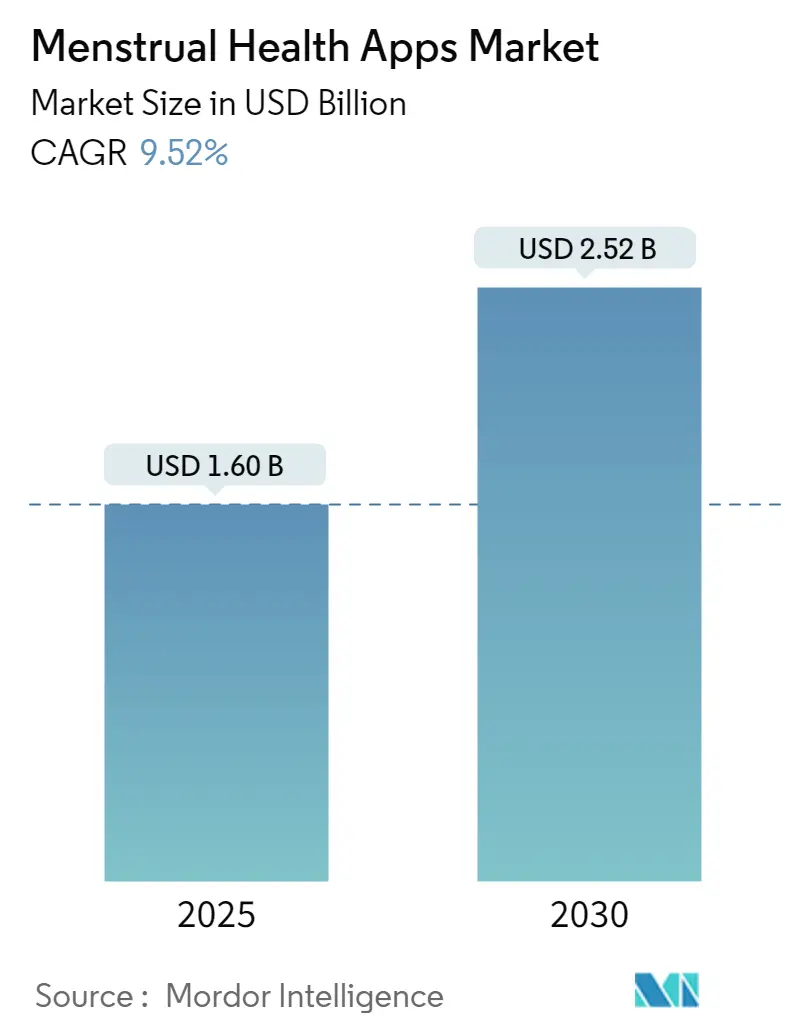
Menstrual Health Apps Market Analysis by Mordor Intelligence
The Menstrual Health Apps Market size is estimated at USD 1.60 billion in 2025, and is expected to reach USD 2.52 billion by 2030, at a CAGR of 9.52% during the forecast period (2025-2030).
The COVID-19 pandemic had a positive impact on the market. Menstrual health apps witnessed significant spikes in the adoption rate and recorded a dramatic rise in the number of users. Female communities across the globe were using femtech applications to maintain a healthy lifestyle and well-being. For example, the NCBI published a study in 2021 that looked at the impact of COVID-19 on menstrual cycle distress and the use and adoption of mobile apps by women during the pandemic.As per the results, around 77.9% of respondents reported using menstrual health-related mobile apps during the pandemic. This signifies that digital health technologies for women gained traction during the pandemic.
In addition, established players are developing their apps in multiple languages to expand their clientele across the globe. For instance, Flo Health Inc. launched Flo, a menstrual and pregnancy tracking app, in 22 languages. The app allows users to track pregnancies and monitor fetal development and offers personalized daily informational content. Furthermore, Flo reported that around 35 million users were using its app monthly in 2020, with a total of 150 million installations.
Rising consciousness about menstrual health among women, the rise in digital literacies and smartphone adoption, increased internet accessibility, and the incidence of growing awareness of menstrual health hygiene are the factors driving the growth of the menstrual health apps market over the forecast period.
The rise in digital literacies and smartphone adoption is also propelling the growth of the market; for instance, in 2021, the International Telecommunication Union showed that uptake of the internet has accelerated during the pandemic. In 2019, 4.1 billion people (54 percent of the world's population) were using the internet. Since then, the number of users has surged by 800 million to reach 4.9 billion people in 2021 (63 percent of the population).
In addition, new menstrual app launches and strategic activities by major players in the market are positively affecting the growth of the studied market. For instance, in December 2020, the LAIQA brand launched an app called Period Pal. This app can chart their menstrual cycles, as well as their energy levels, symptoms, and ovulation cycle predictions.
Furthermore, the growing focus of companies on developing advanced services and adopting various business strategies, such as collaborations and acquisitions, to maintain their market position is also contributing to market growth. For instance, in May 2022, Fertility Company Aprecicity acquired Period Tracking and Community Support App Woom, a women's health app offering period tracking and community support for those trying to conceive. Therefore, owing to the aforementioned factors, it is anticipated that the studied market will witness growth over the analysis period.
Global Menstrual Health Apps Market Trends and Insights
The Menstrual Health Management Segment is Expected to Witness Growth Over the Forecast Period
The menstrual health management segment is expected to witness significant growth in the menstrual health apps market over the forecast period owing to factors such as rising awareness of menstrual health, strategic initiatives by key market players, and technological advancement in menstrual health apps.
The rising awareness of menstrual health is the key factor driving the demand for menstrual health management. For instance, in July 2022, the National Library of Medicine published an article on menstrual hygiene management knowledge, practice, and associated factors among schoolgirls that showed approximately 66% of respondents had an adequate understanding of and experience managing menstrual hygiene.
Growing awareness about women's health and initiatives to actively address it through digital technologies are driving segmental growth. For instance, UNICEF developed the app Okay for girls that will provide information about periods to young girls and also include an individualized cycle tracker. Government agencies are continuously working on spreading awareness related to women's health, promoting advancements in mobile technologies, introducing favorable policies, supporting startups, and improving network connectivity. Such support is expected to drive the vertical in the near future.
The developer and manufacturer of smart wearables and mobile application developers are integrating their innovative product development strategies to efficiently cater to the requirements of women's health management. Through such devices and applications, the female population can easily track their health condition, receive information related to their queries, and engage with healthcare professionals and female communities. For instance, the new Apple Watch Series 8 comes with a pair of temperature sensors that can detect changes in the body temperature to track illness and the menstrual cycle. The watch comes with built-in menstrual cycle tracking apps. Their upcoming watches, OS 9 and iOS 16, will also consist of a cycle-tracking app that will be able to detect abnormalities in the user's cycle depending on the data the user has fed in. Therefore, the Menstrual Health Management segment is expected to witness significant growth over the forecast period due to the abovementioned factors.
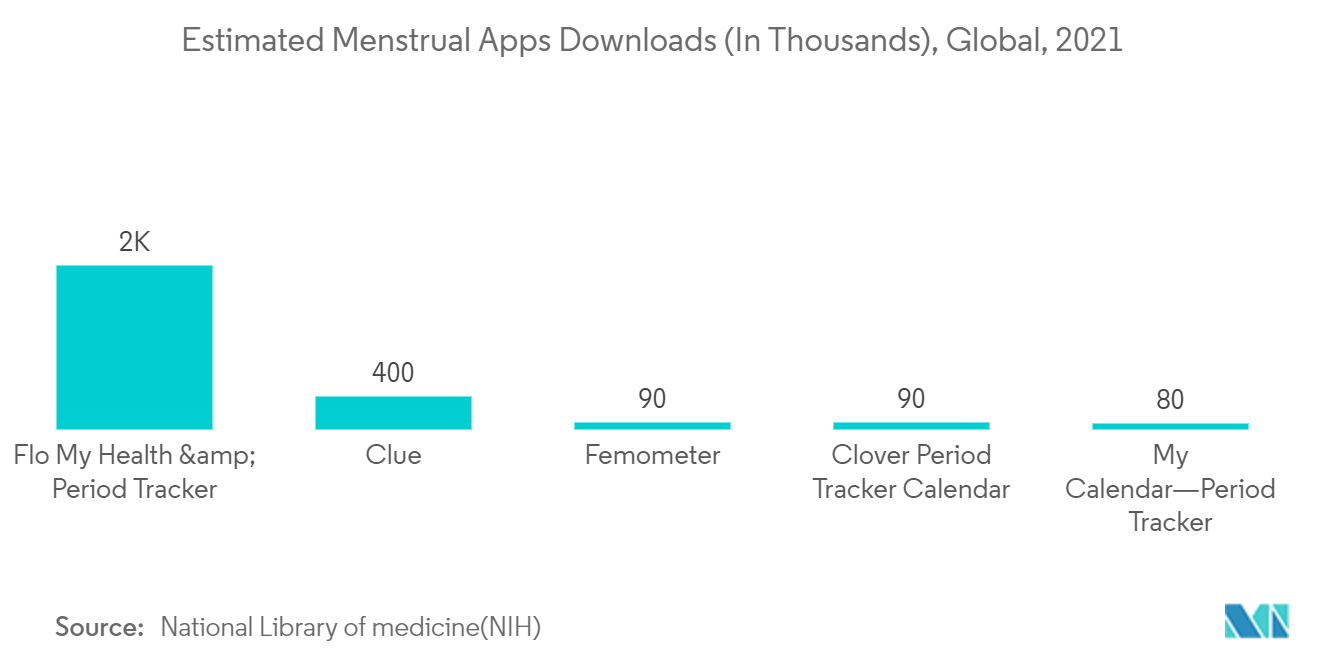
North America is Expected to Dominate the Menstrual Health Apps Market During the Forecast period.
North America is expected to dominate the menstrual health apps market over the forecast period owing to factors such as increasing research and development activities, the significant presence of key players, the adoption of various strategies initiated by key companies to increase mobile phone penetration, rising demand for period cycle tracking apps, and new product launches.
Furthermore, rising women's awareness of menstrual issues is a factor driving market growth over the forecast period.For instance, according to the widespread impact of period poverty on the United States, students surveyed in 2021 stated that 77% of them felt there needed to be more in-depth education about menstrual health, and 73% agreed that education around menstrual health should be part of the core curriculum. There should be free menstrual products, and 65% agree that society teaches people to be ashamed of their periods. Such a study implies that there is a high need for menstrual health awareness and supportive initiatives, which is likely to open growth horizons for the regional market over the forecast period.
Additionally, increasing research and development activities in menstrual health apps and health technologies in the region is likely to boost market growth. For instance, in March 2022, Sasha Cayward launched a new menstrual health app that not only tracks a user's period and symptoms but also uses AI technology to provide personalized nutritional, fitness, and task management advice to improve the user's daily life. Therefore, owing to the aforesaid factors, the growth of the studied market is anticipated in the North American region.
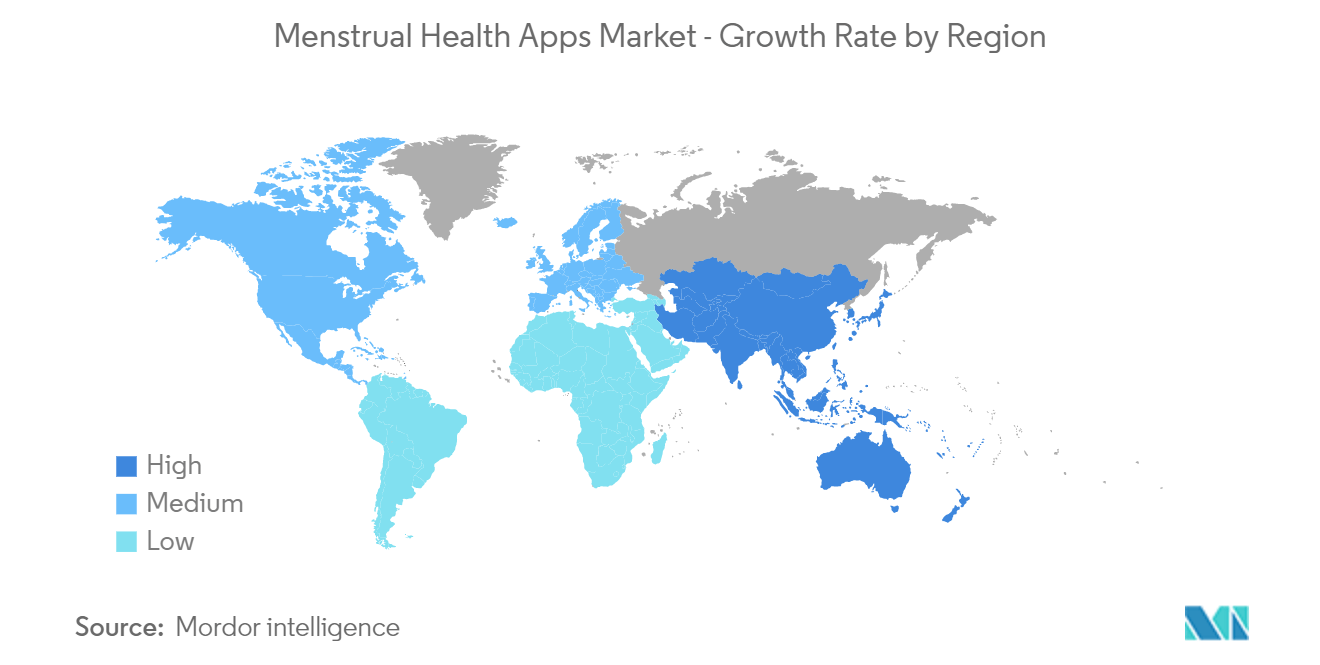
Competitive Landscape
The market for menstrual health apps is emerging and consolidating. Leading players deploy numerous strategic initiatives that include competitive pricing strategies, partnerships, product expansion, sales and marketing initiatives, and mergers and acquisitions. Some of the key players in the market are Flo Health, Eve by Glow, Glow Inc., BioWink GmbH, Planned Parenthood, Ovia Health, Period Tracker, Magic Girl, Perigee, and Apple Inc., among others.
Menstrual Health Apps Industry Leaders
-
Flo Health
-
Eve by Glow
-
Glow Inc
-
Biowink GmbH
-
Ovia Health
- *Disclaimer: Major Players sorted in no particular order
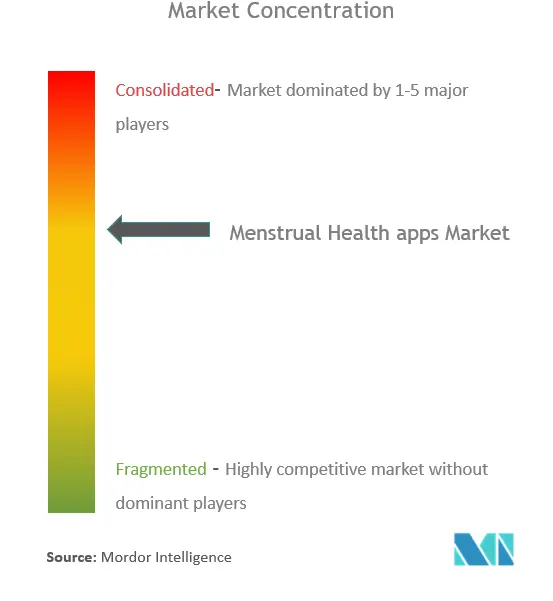
Recent Industry Developments
- August 2021: Always and Thrive Global launched the first period tracker and wellness app that helps end period poverty. This free mobile app is designed to help track cycles in less than 30 seconds and improve holistic well-being.
- June 2022: Sirona launched India's first period tracker on WhatsApp. The company believes that with the introduction of this capability, Sirona will literally put a crucial tool at the fingertips of all menstruators. The period tracker can be used to track three goals: tracking periods, conceiving, and avoiding pregnancy.
Global Menstrual Health Apps Market Report Scope
As per the scope of the report, the menstrual health application allows women to track their menstrual cycles and receive a prediction for their period dates. Most apps also provide predictions of ovulation day and the fertile window. The menstrual health apps market is segmented by application type (period cycle tracking, fertility and ovulation management, and menstrual health management), platform type (android, iOS, and other platforms), and geography (North America, Europe, Asia-Pacific, the Middle East, Africa, and South America). The report offers the value (in USD million) for the above segments.
| Period Cycle Tracking |
| Fertility & Ovulation Management |
| Menstrual health Management |
| Android |
| iOS |
| Others |
| North America | United States |
| Canada | |
| Mexico | |
| Europe | Germany |
| United Kingdom | |
| France | |
| Italy | |
| Spain | |
| Rest of Europe | |
| Asia-Pacific | China |
| Japan | |
| India | |
| Australia | |
| South Korea | |
| Rest of Asia-Pacific | |
| Middle-East and Africa | GCC |
| South Africa | |
| Rest of Middle East and Africa | |
| South America | Brazil |
| Argentina | |
| Rest of South America |
| By Application | Period Cycle Tracking | |
| Fertility & Ovulation Management | ||
| Menstrual health Management | ||
| By Platform | Android | |
| iOS | ||
| Others | ||
| Geography | North America | United States |
| Canada | ||
| Mexico | ||
| Europe | Germany | |
| United Kingdom | ||
| France | ||
| Italy | ||
| Spain | ||
| Rest of Europe | ||
| Asia-Pacific | China | |
| Japan | ||
| India | ||
| Australia | ||
| South Korea | ||
| Rest of Asia-Pacific | ||
| Middle-East and Africa | GCC | |
| South Africa | ||
| Rest of Middle East and Africa | ||
| South America | Brazil | |
| Argentina | ||
| Rest of South America | ||
Key Questions Answered in the Report
How big is the Menstrual Health Apps Market?
The Menstrual Health Apps Market size is expected to reach USD 1.60 billion in 2025 and grow at a CAGR of 9.52% to reach USD 2.52 billion by 2030.
What is the current Menstrual Health Apps Market size?
In 2025, the Menstrual Health Apps Market size is expected to reach USD 1.60 billion.
Who are the key players in Menstrual Health Apps Market?
Flo Health, Eve by Glow, Glow Inc, Biowink GmbH and Ovia Health are the major companies operating in the Menstrual Health Apps Market.
Which is the fastest growing region in Menstrual Health Apps Market?
Asia-Pacific is estimated to grow at the highest CAGR over the forecast period (2025-2030).
Which region has the biggest share in Menstrual Health Apps Market?
In 2025, the North America accounts for the largest market share in Menstrual Health Apps Market.
What years does this Menstrual Health Apps Market cover, and what was the market size in 2024?
In 2024, the Menstrual Health Apps Market size was estimated at USD 1.45 billion. The report covers the Menstrual Health Apps Market historical market size for years: 2019, 2020, 2021, 2022, 2023 and 2024. The report also forecasts the Menstrual Health Apps Market size for years: 2025, 2026, 2027, 2028, 2029 and 2030.
Page last updated on:
Menstrual Health Apps Market Report
The Menstrual Health Apps market is segmented by application type, platform type, and geography. The application types include period cycle tracking, fertility & ovulation management, and menstrual health management. The platform types are categorized into Android, iOS, and other platforms. Geographically, the market covers North America, Europe, Asia-Pacific, the Middle East and Africa, and South America.
The industry report offers a comprehensive market analysis and market research, providing insights into market trends, market growth, and market forecast. The industry analysis includes a historical overview and a market forecast outlook. The report also highlights the market leaders and provides a detailed market review.
Industry reports and industry research are essential for understanding the market size and market value. The report includes industry information, industry outlook, and industry statistics. It also provides a report example and a report PDF for further reference.
The market segmentation and market data are crucial for identifying market opportunities and challenges. The industry trends and industry sales are analyzed to understand the market dynamics. The report also includes market predictions and market overview, providing a holistic view of the market.
In summary, this report offers valuable insights into the menstrual health apps market, including market segmentation, market value, and market outlook. The industry analysis and industry trends provide a comprehensive understanding of the market, making it an essential resource for research companies and industry stakeholders.
